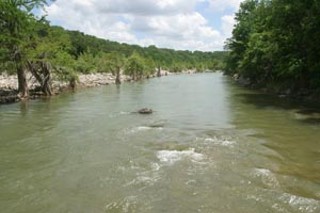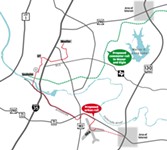The LCRA Moves to Turn on the Tap
The future of the Hill Country waits on Authority's decisions on water plan
By Amy Smith, Fri., Dec. 3, 2004

"We pray ... that you will give us knowledge and wisdom and understanding, that we might make good and godly decisions that will bless our customers and this organization, LCRA."
– Invocation at the Sept. 14 LCRA board meeting
We've all heard the arguments against expanding water utility service to environmentally sensitive areas west and southwest of Austin, where the Lower Colorado River Authority is projecting a thriving customer base to sprout over the next 30 years. While the LCRA sees "strategic investment" opportunities for community development in an ecologically unique region replete with songbirds and clear-running creeks, other residents and community activists see a planning and environmental nightmare that could ultimately destroy that little piece of heaven known as the Hill Country.
The utility has crafted a road map based on a 30-year growth projection of 125,000 new arrivals to western Travis and northern Hays counties, an area that is currently home to about 30,000 people. These assumptions are reinforced by the Authority's desire to lead the way. But is the LCRA headed in the right direction? Not when weighed against the "plan first, build second" mantra of stakeholders involved in three regional and county planning efforts (made possible, as it happens, through more than $200,000 in funding from the LCRA; see "We Had a Little Plan," p.35). Within that context, community and environmental participants would like to promote a primarily eastward growth trend, relatively limited density on the western front, and stricter water quality measures – all intended to ensure the longevity of the Hill Country landscape, its network of lakes and creeks, and, of course, Barton Springs. These goals are in keeping with the mission of the far-reaching Envision Central Texas project, an inclusive planning process that kicked off two years ago (again, with substantial financial backing from the LCRA) as a means of giving communities a voice in growth management. The question remains: Will that voice be effective or simply one more public relations element in the agency's visible determination to move ahead on speculative water sales, whatever the outcome of the planning process?
Apart from land-use issues, there are serious concerns about the LCRA's ability to advance its plan before resolving some financial and organizational problems within its fledgling retail water operations. These problems have only recently begun to spark candid discussions between the board and the utility's brass. "It's essential that we have our business house in order," one director sternly told General Manager Joe Beal at a September board meeting. As a 70-year-old electricity and water/wastewater outfit, the Authority has had decades to hone and grow its greatest achievements – power and wholesale water. The utility isn't yet as seasoned in running a retail water business, where costly errors and a $16 million annual debt load naturally raises questions, both inside and outside the Authority, about the wisdom of piling on more debt by venturing into politically and geologically rocky territory.
West vs. East
As it happens, the Authority sprang from the failings of another utility – a Chicago-based concern that went bankrupt in 1931, midway through construction of the Hamilton Dam in Burnet Co. A young Texas state senator and water lawyer, Alvin Wirtz, drafted legislation to create the public, nonprofit LCRA in order to complete the Hamilton Dam project with public funding. The measure failed three times before Gov. Miriam A. "Ma" Ferguson signed it into law in 1934. Construction on the dam wrapped up in 1937 (setting off a succession of other dam projects) and was renamed after its biggest ally in Congress – J.P. Buchanan, who died the same year. His death effectively launched Lyndon Baines Johnson's rise to power. It was Johnson who urged his friend Wirtz and the LCRA to begin capitalizing on the electricity generated at the dams. The idea fit neatly into Johnson's campaign bid for Buchanan's congressional seat, and he ran on a promise of bringing electricity to rural areas throughout the Hill Country. From there, the utility grew its electric empire before jumping into the business of providing irrigation water to farmers, while simultaneously expanding its water rights on the Colorado River.
Today, Wirtz and Johnson are remembered as the guiding lights of the organization, and electricity is still its main financial asset, representing 90% of the $880 million revenue stream, followed by wholesale water. The LCRA waded into retail water operations about 10 years ago, but the learning curve has been very steep, due largely to the classic business mistakes that follow growing too fast. In fairness, much of the water utility's financial losses came from takeovers of antiquated, and therefore costly, water and wastewater systems in small communities. As a publicly funded institution, the LCRA can't easily turn down requests from municipalities or small private operators eager to get out of the water business, even if it means the Authority must accept difficult financial burdens. Saying no would be a rejection of its mission as a water provider.
But now, broadening that mission is a new agenda to get ahead of the growth that Beal believes is inevitable in what is now vast, hilly open space to the west of Austin, an extension of massive subdivisions cropping up in Hays County. Beal wants to extend service from the existing LCRA water line along U.S. Highway 290 to new developments built since that pipeline began flowing in 2002. Yet the proposal itself serves to bear out opponents' claims at the time that the line would promote more growth in the Barton Springs watershed. Local officials and the LCRA brushed aside the warnings, but here we are today with four new Hays Co. subdivisions in the works, the largest being Cypress Realty's planned 2,700-home development. If the LCRA carries out Beal's plan, many people are predicting a repeat performance to play out in western Travis Co. One of LCRA's own environmental consultants, Brigid Shea, whom Beal hired to help him, as he put it, "interface" with the environmental community, has told Beal straight up that west is not the way to go. "I have told [Beal] and the board how I feel about this," Shea said, "and I've urged them to go east."

The Authority's board of directors will hear all sides of the east vs. west debate at a special meeting on Dec. 7, when it considers the first sliver of the utility's sweeping $225 million plumbing plan. Beal is requesting approval to extend a surface water pipeline to the Hamilton Pool Road area – one of the prettiest pieces of the LCRA puzzle. The immediate proposal calls for installing a line to serve three different proposed subdivisions on properties along the road, adjacent and across from one another. It's uncertain whether the board will consider an equally dicey subject – extending the line to existing homeowners on Hamilton Pool Road, many of whom have been waiting years for piped-in surface water to replace a slowly depleting supply of groundwater (see "LCRA's $10,000 'Stepchildren,'" p.36).
For now, it is the new, dense developments that are given precedence because they're built with the necessary infrastructure to tap into the LCRA line, unlike those existing homes on well and septic systems. The first development plan to move forward is Rebecca Hudson's Rocky Creek Ranch, which calls for 468 homes to be "clustered" on 15% of a 468-acre tract, with open space designated for the remainder. The site is just outside the contributing zone of the Edwards Aquifer and alongside Rocky Creek, a lovely spring-fed stream that flows into Barton Creek. The plan has received preliminary approval from Travis County, and Hudson, who intends to maintain her residence on the property, now awaits the LCRA board decision on a crucial element – water.
Red Flags Rising
By most accounts, the LCRA board has emerged in the past six months as a group of independent voices, shedding its image as a rubber-stamp collection of anonymous faces from far-flung spots within the Authority's vast service area. The 15 directors are appointees of former Gov. George W. Bush and his successor Rick Perry, who is said to be watching this discussion closely, from a pro-pipeline perspective that would presumably connect to his own road-driven vision for growth. The board has already once delayed a vote on the Hamilton Pool Road proposal, for six months, and planning advocates believe a second postponement is in order, to await the completion of at least one of the three planning efforts under way for the area. The largest study of the three, the Regional Water Quality Protection Project, is in its first draft form and undergoing review. Terry Tull, the group's executive director, expects to have a final draft completed by February. The long-range objective – laid out two years ago by Austin City Council Member Daryl Slusher and Hays Co. Judge Jim Powers – is to get some sort of uniform ordinance in place for the Barton Springs watershed, which includes Hamilton Pool Road. Meanwhile, environmental and planning advocates continue pressing their arguments against the LCRA's expansion into the Hill Country.
Enter the mayor of Sunrise Beach, a sleepy little hamlet on the shores of Lake LBJ, 60 miles northwest of Austin. Mayor Patricia Frain may have unintentionally handed the pipeline opponents their best weapon yet: documented evidence supporting arguments that the LCRA should get its financial and management affairs in order before heading west on a speculative venture. Frain, a no-nonsense Air Force retiree in her second term as mayor, never dreamed she'd be launching a one-woman investigation into the inner workings of the LCRA. But after hitting brick walls on questions she had about rising water rates, she took matters into her own hands. "I'm pretty mild-mannered and easy to get along with," Frain said, and not in the habit of going looking for trouble. But two months of getting the runaround had worn her down. "That's when the gloves came off."
The mayor filed a very detailed open-records request for copies of contracts, memos, e-mails, and any other documents pertaining to the Sunrise Beach water system, starting from the time the LCRA took over the aging water plant, about six years ago, and proceeding through this year. She asked for information on bidding procedures for outside contractors, documents relating to a well-conversion project, a detailed breakdown of all costs, and finally an organizational chart of LCRA's water services division. As Frain explained, "I felt that one or more of the areas contained the answer to the problem." Unbeknownst to LCRA officials, the mayor knew exactly the sort of red flags to look for, drawing on the years she spent analyzing contracts and management services in the Air Force.
Frain organized her information, prepared a report, and presented her findings – this time to the board of directors during a two-day meeting that took place Sept. 14-15 at Lake Buchanan. (She had already provided Beal with a preview.) "Instead of continuing to battle the large increases each year, which are only the result, or the symptom, of a problem," Frain began, "I went to look for the cause of the escalating rates." The cost increases to Sunrise Beach customers started the second year after LCRA took over the town's outdated water system and continued through to the existing monthly base rate of $46 per 3,000 gallons.
The utility also projected future rate hikes – to $65 in 2005, and $72 in 2006 (those increases are now on hold). "Each of these increases were accompanied with charts showing that LCRA isn't meeting its expenses, even with the increase," Frain said. She found her answers in the pile of contracts with outside engineering firms that the Authority hired to bring the town's outdated water system up to modern-day standards. The firms would routinely submit change orders that doubled and tripled the costs of the original contracts. Sunrise Beach customers paid the price. Buried in the reams of official documents, the mayor discovered an e-mail in which one consultant expressed concern about the costs of the project. Frain quoted from the e-mail reply of the staff project manager: "Don't worry about it. The cost will be passed on to the tap owners." She paused a couple of seconds to let that soak in. "This reinforces the public opinion that LCRA is a cost-plus operation."
Frain also came across another document – a letter to the LCRA from its billing contractor, which noted it had inadvertently overcharged Sunrise Beach customers by $90,000. The contractor corrected the error in April with a $90,000 refund to the utility – but ratepayers had yet to be credited for the amount. (The LCRA has since moved to make amends.)
Robert Cullick, the utility's chief spokesman, points out that the mayor has been asked to serve on a special advisory committee made up of LCRA's water/wastewater customers. "She brought a lot of issues to our attention, and we've tried to respond to her concerns to the fullest of our ability," he said. "And I think she will tell you she has received a satisfactory response. That's frankly the way it's supposed to work." Indeed, it took bringing the problem directly to the board's attention to get response from LCRA management, but Frain is generous with her praise of what has transpired since then. "Once you've got the board's attention, then you're three-quarters of the way there," she said. "They have not been in retail sales very long, and I don't think they were good at it. But they're going to be getting better."
On the whole, the Authority owns about 35 water/wastewater systems and counts only a handful of them as major headaches – for the utility and the customers. On this matter, elected officials from the likes of Sunrise Beach and little Lometa in Lampasas Co. have managed to get their concerns across to the board, and the board is not happy with the Authority's performance. Still, for all its missteps in the retail area, said Beal, "There are 167,000 [customers] out there, and the vast majority of them are as happy as pigs in slop."
In slop or in a poke, the public airings of the utility's internal woes have placed more pressure on Beal and his lieutenants to prove to the board that the retail division is capable of taking on new projects without turning them into money pits. So there is a lot riding on the 30-year plan. At the same time, the proposal is causing a good deal of angst among many of LCRA's staff of dedicated environmentalists, ranging from engineers to some of Austin's greenest tree huggers. They're the ones credited with building and maintaining LCRA's image as a progressive (and well-paying) institution, which is partly why the Legislature doesn't always look kindly on the Authority. Between its water business problems and staff ambivalence about heading west, the LCRA is at the crossroads of deciding its future. By extension, the natural and human future of the Hill Country has become thoroughly entwined with the institutional future of the LCRA – and it remains unclear whether what might be good for the LCRA is necessarily good for an irreplaceable piece of Texas.

For their part, some board members are also starting to echo the staff's apprehension about the risks – financial and otherwise – of building a pipeline to the west, when the east holds much fewer limitations. "I know that we struggle a lot as a board," director Rosemary Rust told Beal, "and I'm certain there's a lot of ambiguity with staff [about] developing in environmentally sensitive areas, when the projections show that it's going to be easy east of I-35 because there's going to be a lot of growth there."
"What do you think we should do, Rosemary?" Beal asked.
"Personally," she said, "the easier stuff that would ... pay for itself. It's just one of those 'duh' issues."
That sentiment, echoed by half a dozen other board members, is what is giving opponents of the LCRA proposal renewed hope of getting a regional plan in place before the pipeline is built. "The board members are finally asking the questions they should have been asking all along," said one observer close to the issue. "The idea is, 'Let's have some planning in place first.' The LCRA is in a position to do more for this part of the country than anyone else. They have the ability to be great environmental leaders."
Opening Act
Along Hamilton Pool Road, many residents are vocally unhappy over the prospect of what they believe will become suburban-style subdivisions, with homes crammed on small lots, thousands of additional cars on the narrow roadway, and the general disruption of a quiet, rural community. Among the leaders of the opposition are Rebecca Hudson's neighbors, Gene and Linda Lowenthal, who fear their 58-acre property, where their hilltop home takes in expansive views of Rocky Creek and well into the Hill Country, will lose both its monetary and aesthetic value. "People move out here to enjoy a rustic lifestyle – that's what makes this area so unique," said Gene Lowenthal, a leader in the Hamilton Pool Road Scenic Corridor Coalition, as well as the larger Hill Country Coalition, which represents the interests of communities that fall within LCRA's vision for this area of Travis and Hays counties. In Lowenthal's view, Hudson's compliance with U.S. Fish & Wildlife Service guidelines, as well as the development's "clustered" effects to create open space, are just old-fashioned "greenwashing." "The primary benefit is to the developer," he said. "Clustering is really a way of making water affordable – and encouraging density at the same time."
Most recently, the LCRA asked Hamilton Pool Road developers to comply voluntarily with the agency's nonpoint source pollution ordinance, which had not extended to the Barton Creek watershed, where Fish and Wildlife standards apply. Apparently the utility does have the authority to regulate this environmentally sensitive, unincorporated area of the county. (So far, no developer has committed to comply with the ordinance.)
Hudson defends her proposed plan, pointing out that she has given the development a lot of thought from an environmental perspective, and has spent two years trying to draw up a sensible, environmentally sound blueprint that follows Fish & Wildlife guidelines. "I live right next to this creek, I love this creek, and I'm not going anywhere," said Hudson, "so I'm as interested as anybody in ensuring that we do this the right way."
In addition, Hudson said she is exploring more innovative water-conservation and -reuse measures and has hired Kent Butler, a UT professor of community and regional planning, to study various rainwater collection system scenarios. She is also talking to home-builders experienced with integrating such systems into their developments. Taken by itself, the Hudson plan might not be drawing such broad opposition, but longtime residents throughout the region see the development as the camel's nose under the Hill Country tent. LCRA's Beal persistently argues that growth will happen in this area. "We want to get ahead of the growth," he told his board in September. Christy Muse, a Hill Country Coalition leader, agrees that growth will happen if the board approves Beal's proposal. "It's just the first step in what will be a massive web of developments out here," she said.
Indeed, developments are in progress or are on the drawing board for the village of Bee Cave and areas farther west along Highway 71, headed toward the Pedernales River and beyond. Two of the larger residential projects include the Lazy 9 Ranch subdivision of 2,300 homes, which got preliminary approval from Travis Co. for the first phase, and last year secured legislation to create a Municipal Utility District. (A lawsuit brought by the Save Our Springs Alliance against Lazy 9 went to trial in November, and a final ruling is expected early this month.) Also, West Cypress Hills, a 435-home subdivision under development, was practically a household name much of the year in frequent media reports from the site because of a storm water detention pond and dam's failures to keep sediment-laden runoff from spilling into Lick Creek. Both the creek and area residents bore the brunt of the pollution from the construction site, and a lawsuit is pending on the matter. The developer has in recent months taken corrective measures – which appear to be working this time – and there have been no reports of unnaturally sullied waters since September.
Meanwhile, one of those "I told you so" environmental disasters is playing out in Bee Cave, where a vast commercial center under construction, the Shops at the Galleria, wreaks havoc on Little Barton Creek each time it rains, prompting visits and recommendations (but no sanctions thus far) from state environmental inspectors. And in Hays Co., it goes without saying that more developments will spring from the U.S. 290 pipeline in the vast extraterritorial jurisdiction of Dripping Springs.
The LCRA believes that with a Certificate of Convenience and Necessity, which it hopes to obtain from the Texas Commission on Environmental Quality, it could force developers to comply with Fish & Wildlife environmental standards as a provision for receiving surface water. But skeptics believe the utility wants the CCN for one reason: to keep out the competition so it can charge the rates necessary to cover the expense of its westward business venture. Longtime residents and Hill Country advocates are asking: Why should LCRA effectively accelerate the growth by opening the tap to readily accessible water, the lack of which would act as a natural brake on speculative or unsustainable development? "This will be the first domino to fall," said Gene Lowenthal. "This is just the first act of a long play." ![]()
Got something to say on the subject? Send a letter to the editor.










